This article is a companion piece to the Eating of Persimmons, published on the Birdsong Orchards farm blog here.
Four years ago, in the winter of 2014/2015, we planted around forty persimmon trees in our orchard. Most have thrived, a few have died, a few more have been planted, and I have learned a few things along the way. I cannot claim to be a master of persimmon horticulture, for my trees are still young and have many years of growing to do, but I’d like to share what I know.
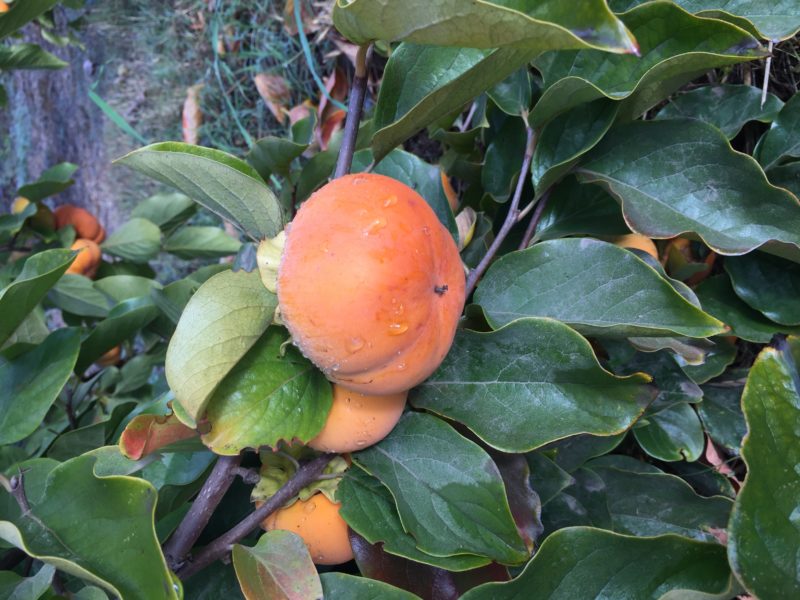
Let me start with this: persimmons have proven to be one of the best and most satisfying fruit tree species we grow in our orchard on the California Central Coast. They are disease free so far, and have had very low gopher pressure, especially compared to the poor figs just a few rows up. The persimmon trees have grown fast, and we got our first decent harvest from these relatively young trees this fall. They are graceful trees, and provide the best autumn show of color of any fruit tree I have seen in California.
Persimmon Varieties & Sourcing
There are dozens if not hundreds of other varieties of persimmons grown commercially in Japan, China and Korea, but I have found them next to impossible to find here in the US. If anyone has any leads, please let me know! In the meantime, here is a tantalizing random internet photo I found, mostly showing varieties I have never heard of.
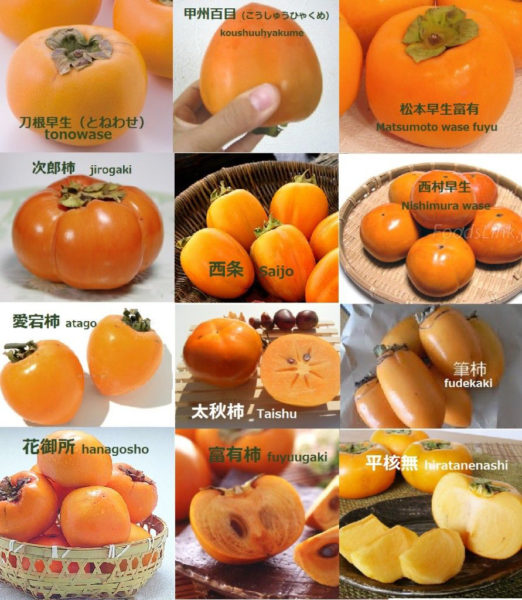
I have also seen rare glimpses online of mysterious purple and blue skinned persimmons from Korea, but I have never found a source for them. There is one variety from the graphic above I AM growing, and that is Saijo. I am told Saijo means “the very best one” in Japanese, and I agree with that statement 100%. I’ll be providing some Saijo scion wood at the Scion Exchange 2019, so keep an eye out for it if you are interested.
I am growing 8 varieties in total so far: Fuyu and Hachiya of course, but also Saijo, Tamopan, Izu, Chocolate, Honan Red and Imoto. All of my trees were purchased bareroot from Trees of Antiquity, who I recommend so highly, and are grafted onto Lotus rootstock. I have only lost two trees, due to trunk damage from weed whipping around them when they were very young I think.
Other online sources for persimmon trees I like are:
Locally, I have seen persimmon trees for sale at Far West Nursery and San Lorenzo Garden Center in Santa Cruz, as well as Mountain Feed in Ben Lomond.
Planting & Fertilizing
Look for bare root trees in the winter, January – February time frame ideally, and plant your trees well before bud break. I generally head back bare root trees to about 3 feet and remove any spindly side shoots at the same time. I plant new trees with a handful of Mykos mycrorhizzal fungal inoculant applied around the roots, then mulched with a good layer of wood chips. I have two lines of Netafim 1/4” drip irrigation on either side of the persimmon row, and I have found the trees need an average amount of irrigation, not as much as my figs but more than my apples. I think I will probably add a third row of irrigation line this spring.
I have given the trees an annual meal of organic granular fertilizer at a rate of one cup per inch of trunk diameter every spring. I generally give all my orchard trees a late spring foliar feed with kelp, fish emulsion and neem oil as well. The only nutrient peculiarity I have learned of persimmons so far is this: the non-astringent Fuyu variety requires additional iron, or I have a problem with pale and anemic new growth. I have found applying a liquid iron feed to the roots in March helps with this problem, whereas a foliar spray tends to burn the new leaves.
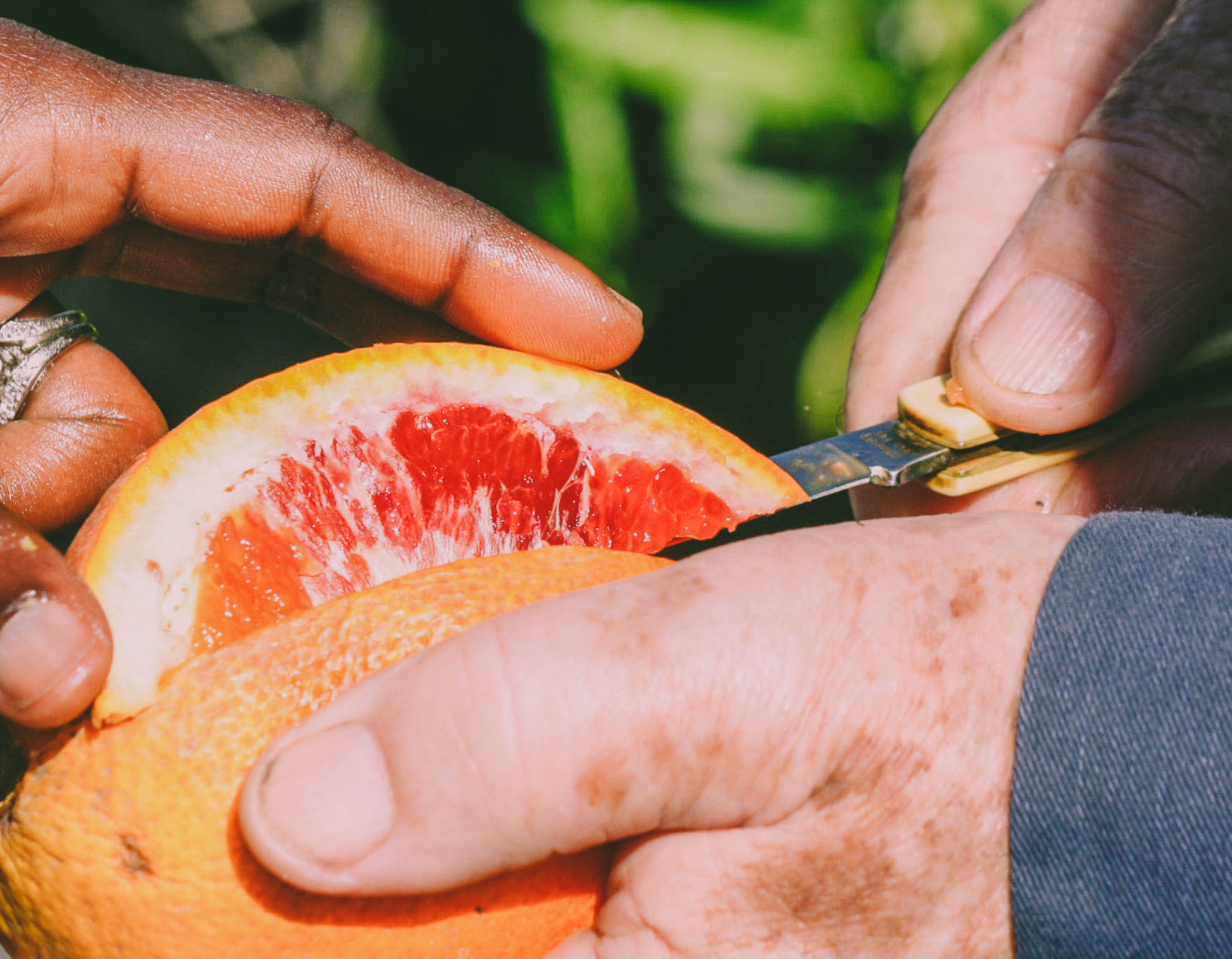
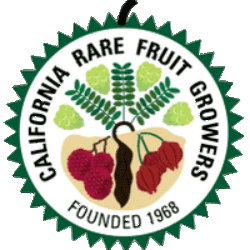
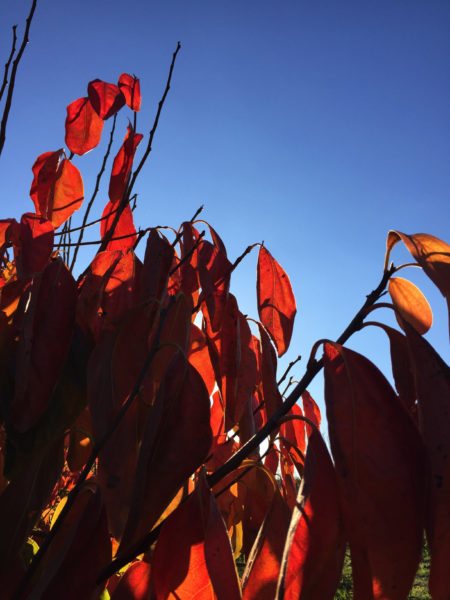
Thanks Nadine, I loved you post!
I just wanted to add for those grabbing scionwood at the exchange this year (Andy Mariani from Santa Clara often sends over a good selection from his extensive collection as well), Persimmons get a bad rap for being hard to graft. They indeed, will not take if you treat them as you would an apple or pear. Persimmons need to be grafted late in the season, like in May, after the stock’s leaves have grown to an inch or so. At this point, a simple cleft graft will take as easily as anything. Also be careful about cutting and grafting onto very large diameter wood. I have had whole branches die-back as a result, and have read they are susceptible, so I’m a little more conservative with them.
Thanks Nadine and Freddy! This was very helpful. I especially appreciate the spacing info. I find myself trying to cram in as much as I can, so it’s always nice to hear when giving one variety a little more space can save you loads of trouble in the years to come. I’m pretty sure that grafting insight just saved my persimmon trees. Haha… I’ll definitely be looking to graft some saijo in May.
Enjoyed the insight into your planting, Nadine, and yeah, I concur with Freddy’s tip on grafting time. My first persimmon grafts failed to earliness. Can’t remember where I heard the folksy rule of thumb that you can successfully graft persimmons once the understock has begun budding out “a squirrel’s ear”, but this has rung fairly true true to me. (An inch is probably even safer.) And go figure squirrels would have robbed an entire one of my young trees of persimmons this season…
This is so good to know! So I will NOT be bringing Saijo cuttings to the scion exchange, but if anyone would like some in May, let me know.
Winter is still the right time to cut and share scions! You’ll want to store and graft those good and dormant, to a tree or rootstock that already has some sap flowing.
Hi , I am Ben from Albania and I want to know how can I get some cuttings of persimmon variety Chocolate and CoffeCake
(buying or exhanging) . I have some italian varieties , (Ragno, Tipo, Vaniglia) , if somebody is interested.
thanks for much good info.Nadine pls do bring some cuttings in May perhaps at an event our chapter will conduct?
Hi Elliot, we’ll most likely have persimmon scionwood at our January 13 2019 scion exchange. Well also have a greenwood-focused exchange in June, perhaps with some persimmon wood there too, if dormant supplies remain.
Thanks to everyone who shared your valuable knowledge.
Nadine, I saw on your website hat you have Tamopan growing in your orchard. How do you find their fruits to be? I’m asking because I found a fruit laden tree growing on UCSC farm. I took one of its huge, beautiful acorn shaped fruit to Santa Clara Valley Chapter meeting to see if anyone can identify it. With Irene’s help, I was able find the name “Tamopan” online. I was asked if I could get scion for the exchange. I took a big bundle (taken with permission from the farm manager, of course) to scion prep party yesterday. It’ll get distributed to all 5 local chapters. I’d like to be able to tell people how the fruit taste. And thanks to everyone who shared grafting tips, I’ll be able to pass that information along also.
can persimmon be espaliered?
I’m kinda of the opinion that anything can be anythinged, though I’m not sure that persimmon would be the most amenable to a super tidy espalier, as they’re pretty leggy and tend to bear towards the end of twigs. That said, check out this awesome image of [redacted blurry image of ostensible espalier-ish high density persimmon orchard]
That looks like an apple plantation… o.O
Dont you have a pic closer of the fruits?
Good gravy upon zooming in this is absolutely some sorta UHD apple system. Bad google, and I must have submitted this on my phone without double checking. Thank you Ferenc for catching this! I’m gonna remove the image from above comment, as it’s come full circle and now appears to be the top image search result itself for “persimmon espalier”… Oof! 🤦
Will definitely stand by my above sentiment that persimmon isn’t particularly amenable to classic espalier. Apples and pears are ideal espalier species for their controlled growth and spur-bearing habit on older wood.
I’ve been trying an informal persimmon espalier, but it’s been really frustrating. As soon as I get a symmetrical branch nicely established, raccoons use it to get at the fruit and break it off.
I’m abandoning a formal structure and starting to ponder raccoon stew. (No just kidding.)
Raccoon stew could be good, 🤨🤔
I gave one the ax for getting ahold of my chickens, my elder family is from the Ozarks and my grandfather talked about the opossum pie Grammy made that stuck to the roof of his mouth and how good it was besides that, (yuk) my mom talked me into putting the meat from the hind quarters in our crockpot, I didn’t trust the meat and figured I’d cook it on low and use it to flavor the dog food with. My sister didn’t know what was in the crockpot and dished herself up some, she said it tastes like roast beef. after she ate it I told her what it was, she thought I was lying to her, a week later she asked what was really in the crockpot, Raccoon I replied.
Question: is there any ultra-dwarf rootstock that will accept a fuyu persimmon scion graft. I ask this because I’ve got other ultra-dwarf fruit trees in my small yard and I don’t want the guy to overcrowd my other trees. Thanks for all the helpful info!
Where can I the get the dwarf root stock for persimons
I am in La Selva Beach, not far from Freddy and am considering grafting Fuju onto Hachiya. Has anyone tried this successfully?
I have grafted Hachiya onto a Fuyu-type (Izu) with good success over its first few years of fruiting the limb. I’d expect that the opposite graft may be even more successful, with Hachiya trees frequently the stronger and more vigorous of the two.
Cheers on a highly readable article on an underrated and gorgeous fruit tree. We bought a home that had an existing mature Fuyu that 25 years on is still thriving but is finally showing some age. Every aspect and characteristic of this beautiful ticks the boxes for a desirable tree to have in the garden. The graceful symmetry of the whole, lovely color and shape of the leaves, fall colors of a sunset, and the fruit color and shape are handsome and stunning. We love our “King of the Fruits”. Easy care for the amateur I am.
Hi. As you noted, persimmon trees will get inconveniently large (both tall and wide), if allowed to. I solved this problem by bending and tying water sprouts, eventually substituting these arched branches for the customary horizontal ones. Water sprouts of 8′ or more can be generated by significantly lowering a tree. If you wanted to try it, either on a few trees or on just part of some trees, you can cut a main limb, down to a height of about 4′ and then bend and tie selected water sprouts that are generated. I’ll be happy to share more details, if you’re interested…
Have you grown or tried Sharon Fruit tree which was modified to rid of the tannins?
A note about the Saijo persimmon:
While “saijo” can be the reading for the word meaning “best” or “top class”, that isn’t true in this case.
According to the Japanese wiki article on the cultivar, it is named after the Saijo area of Hiroshima, where its origins are apparently recorded in the local temple records.
The tree reportedly came about when, in 1239 during the Edo period, a local priest at the Chofukuji temple was spurred by a dream to dispatch a disciple to the Eifukuji Temple in Kamakura to take seeds back to Hiroshima and plant them around the temple grounds. One of the newly planted trees fruited seven years later, giving rise to the Saijo persimmon.
Saijo persimmons were apparently dried and presented to the Shogun annually as a gift.
Although Saijo’s name doesn’t mean “best”, the wiki page does note that it was often referred to in literature as the “king of persimmons”.
Another note about your picture: in Japanese, “wase” means “early-bearing”, so you can safely assume that anything with that in the name is an early variety. (This is true of any fruit in general, not just persimmons.)
I have a small orchard of Fuyu persimmons. My trees are really not fruiting. I had a tissue analysis done but don’t know what deficiency I should be looking for related to lack of fruiting. Do you have any suggestions?